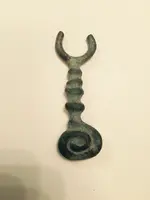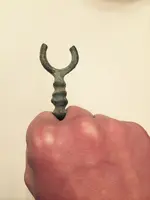How about
you producing evidence of a piece of brass with lead as part of it's composition that is more than 200 years old? The lead content of your
brass object clearly indicates a
machine age or later origination.
The percentages you state as the composition of your piece were derived without exposing fresh metal. I agree with keeping the piece as you found it but surface testing of metal that have been corroded/oxidized will always produce different results than the raw metal as it was cast.
As pointed out by others there have been thousands of different brass compositions used during the machine age that incorporate lead. Very few of those compositions were ever published. Those are known as trade secrets.
Trying to match the exact composition of the corroded/oxidized surface is not a valid test. Weathering changes the surface composition of all metals, some more than others but Copper alloys are well known for significant surface alteration when exposed to air and water. A better test than matching the surface composition would be to establish the earliest period that cast brass had a lead component.
All indications are that the very earliest brass alloys with lead were around 200 years ago. Leaded brass is not a natural alloy and lead has no use in brass unless the brass is intended for machining. There are no known ancient leaded brasses. Show where lead was used in brass more than 200 years ago and you will be on your way to establishing an earlier possible manufacturing date. This is known as researching a piece based on it's physical properties rather than what it might appear to be to the finder.
Another possible piece of the puzzle of age and origin might be solved by finding another object like the one you found. If the two articles are the same in appearance and composition they are likely to have the same origin. Clearly without a very similar object for comparison you can only make wild guesses as to what it's function was. It could be a Pigmy double nostril booger picker, an antigravity key or a trivet. It's all just speculation.
The provenance of the piece is another clue. You found the piece in North America in a wet area with a lot of vegetation. As I pointed out in an earlier post the surface patina of your object is not indicative of being exposed to that environment for a long period of time. The object was recently lost or buried.
The find being in North America and
composed of brass strongly points to a modern manufacture. Unless the piece was brought from a foreign land with a previously unknown ancient leaded brass industry and recently dropped or buried where you found it the odds are very high that it is a modern piece manufactured in the last 140 years.
Belief is a funny thing. Humans can believe in things that are easily demonstrated to be impossible. For example I believe that with enough knowledge and caring there can be peace on earth. Yeah it's silly and obviously isn't going to happen but I do keep that bit of nonsense close to my heart and it makes me feel better. Notice that I keep that in my heart for my feelings. I don't use my mind to try to support that silly belief and I know it's just a feeling and not a fact. I find it helpful if I limit my beliefs to a few good things and let the rest rely on good old knowledge, fact and logic.







 He has a building("forge shop") all kind of tools......And is making a nail?
He has a building("forge shop") all kind of tools......And is making a nail?